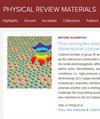Absence of hydrogen insertion into highly crystalline superconducting infinite layer nickelates
IF 3.4
3区 材料科学
Q2 MATERIALS SCIENCE, MULTIDISCIPLINARY
引用次数: 0
Abstract
The discovery of superconductivity in the infinite layer nickelates introduced a materials system analogous to the cuprates for the study of unconventional superconductivity. The synthesis of infinite layer nickelates, (, R = lanthanide) often uses calcium hydride () to facilitate the deintercalation of apical site oxygen atoms from a precursor perovskite () phase via topotactic reduction. However, it remains uncertain whether the use of results in the insertion of hydrogen into the infinite layer structure, and if it does, what the implications are for superconductivity. To quantify the hydrogen composition of highly crystalline infinite layer nickelates, we synthesized thin films on LSAT substrates and conducted time-of-flight secondary ion mass spectroscopy measurements to generate hydrogen depth profiles. We compare the hydrogen density of nickelates prepared with and without a capping layer. Additionally, we measure the hydrogen content in nickelate samples at various doping levels spanning the superconducting phase space, including the underdoped, optimally doped, and overdoped regime. We report no significant increase in hydrogen density between the perovskite and infinite layer phases in any of the measured samples. Furthermore, we put an upperbound on the hydrogen concentration of our nickelate samples to . Our results imply that hydrogen is not responsible for the emergence of superconductivity in the infinite layer nickelates.

高结晶超导无限层镍酸盐中不存在氢插入现象
无穷层镍酸盐超导性的发现为研究非常规超导性引入了一个与铜酸盐类似的材料系统。无穷层镍酸盐(RNiO2,R = 镧系元素)的合成通常使用氢化钙(CaH2),通过拓扑还原促进顶端氧原子从前驱体包晶(RNiO3)相中脱插。然而,使用 CaH2 是否会导致氢插入无限层结构,如果会,对超导性有何影响,目前仍不确定。为了量化高结晶无限层镍酸盐的氢成分,我们在 LSAT 基底上合成了 Nd1-xSrxNiO2 薄膜,并进行了飞行时间二次离子质谱测量,以生成氢深度剖面图。我们比较了使用和不使用 SrTiO3 盖层制备的镍酸盐的氢密度。此外,我们还测量了镍酸盐样品在不同掺杂水平下的氢含量,这些掺杂水平跨越了超导相空间,包括欠掺杂、最佳掺杂和过掺杂状态。我们的报告显示,在所有测量样品中,包晶和无限层相之间的氢密度都没有明显增加。此外,我们将镍酸盐样品的氢浓度上限设定为 Nd1-xSrxNiO2H0.05。我们的结果表明,氢不是无限层镍酸盐出现超导的原因。
本文章由计算机程序翻译,如有差异,请以英文原文为准。
求助全文
约1分钟内获得全文
求助全文
来源期刊

Physical Review Materials
Physics and Astronomy-Physics and Astronomy (miscellaneous)
CiteScore
5.80
自引率
5.90%
发文量
611
期刊介绍:
Physical Review Materials is a new broad-scope international journal for the multidisciplinary community engaged in research on materials. It is intended to fill a gap in the family of existing Physical Review journals that publish materials research. This field has grown rapidly in recent years and is increasingly being carried out in a way that transcends conventional subject boundaries. The journal was created to provide a common publication and reference source to the expanding community of physicists, materials scientists, chemists, engineers, and researchers in related disciplines that carry out high-quality original research in materials. It will share the same commitment to the high quality expected of all APS publications.
 求助内容:
求助内容: 应助结果提醒方式:
应助结果提醒方式:


